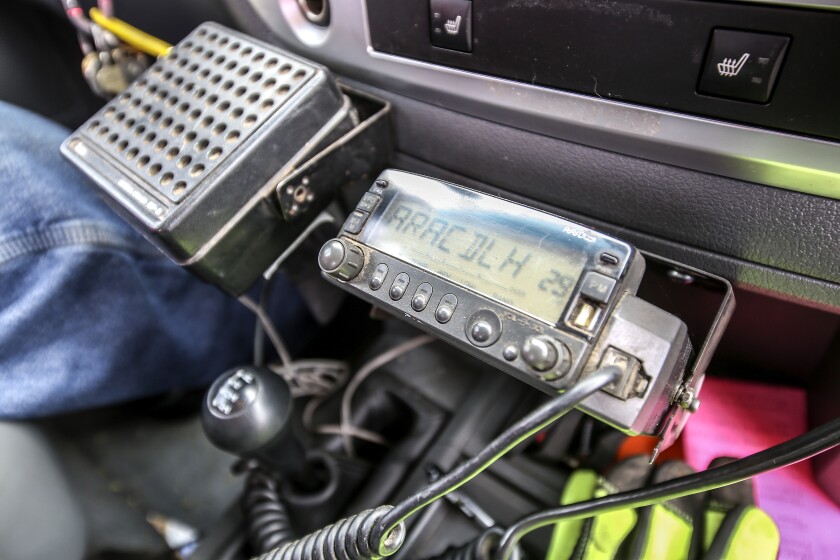When severe weather moves through the region, the National Weather Service in Duluth turns to a network of amateur radio operators to gather on-the-ground weather reports.
The 15 volunteers on the Arrowhead Skywarn Response Team work in shifts at the NWS Duluth office during storms to receive on-the-ground weather observations from amateur radio operators - trained weather spotters from across a 15-county area extending from Koochiching County in Minnesota to Iron County in Wisconsin.
"We get on the radio and we talk to people in the area where the storm is just starting to hit. The meteorologists say they have all kinds of information and they can learn all kinds of things by looking at radar, but they can't tell you exactly what's happening right on the ground," said Grant Forsyth, an operator on the Skywarn team.
Doug Nelson began his involvement in weather spotting in the early 1990s, helping to install the first radio antenna at the old NWS office in Duluth. Now the coordinator for the Skywarn response team, he checks the hazardous weather outlook every morning. When the NWS pages the team to come into the office, they take shifts manning two radios at the NWS Duluth office to talk to radio operators, all of whom have gone through the NWS' Skywarn weather spotter training, Nelson explained. Weather spotting allows operators to use their hobby to streamline information into a central point in order to relay it to meteorologists.
"It's the greatest hobby in the world, as far as I'm concerned. One of the things we do that lends a credibility to having the frequencies we have is that we help out with health and welfare and emergency communications," Nelson said.
ADVERTISEMENT
'Good citizens'
With more than 30 years of volunteering on the response team, Nelson said he continues with it because it "fascinates" him.
Many on the team feel that they're providing a community service, Forsyth said. They're busiest during spring and summer and the members fit volunteering around other responsibilities in their lives.
"The people who go up to the National Weather Service are people that are good citizens. They want to help in the case of a disaster. They want to contribute something to health and welfare and safety. That's how those people have gotten into this. Then you have the people who are calling in from their home. Some of them will measure how strong the wind is - 'hey, we've got trees snapping off here, we have hail' - those kinds of things are important for the meteorologists to have," Forsyth said.
Forsyth received his amateur radio license in 2006 while he was working as a child support officer for St. Louis County. At the time, the Federal Emergency Management Agency was telling counties to have amateur radio operators involved in their disaster plans and someone asked if he was interested in becoming an operator. He then took the NWS Skywarn weather spotter class at an Arrowhead Radio Amateurs Club meeting. He was a weather spotter using his amateur radio from his home or car, but then he was invited to join the Skywarn response team six or seven years ago.
"I kind of lose track. It just kind of happens, you know? You get involved with an organization that's doing something worthwhile and you enjoy going and doing it, that's why I can't exactly pinpoint the number of years I've been doing it," he said.
It's become a passion and taken on a life of its own, helping to fill his time now that he's retired.
"I want to be involved. I want to be able to help. That's the whole gist of the whole thing," he said.
ADVERTISEMENT
'Weather-ready nation'
The team's season typically focuses on rainstorms and runs from April through October. However, the National Weather Service has weather spotters for both thunderstorms and winter storms.
"Our main outreach is for the severe weather, but we really love data here," said Steve Gohde, observing program leader at the NWS Duluth office.
In addition to the more than 2,000 Skywarn weather spotters providing weather updates to the NWS Duluth office, improvements in technology and social media mean the office can receive storm updates as they happen, both from storm spotters and residents, Gohde said. He explained that social media is an important tool for the NWS because they can do a callout on Facebook for weather updates and receive reports from residents who may not be trained weather spotters, but can still comment about what's happening in their neighborhoods.
"I think that social media has been a big plus and even to get real-time images and photos from storm effects, how the storm has impacted areas," he said. "If we see rotation on the radar, it might not necessarily be a tornado on the ground, but if we've got a spotter that's out on the ground taking a video of it and can confirm that, then we know. I always like to thank our observers for their boots-on-the-ground perspective because it's great to have radar, but that's a remote-sensing thing. We need eyes on the skies essentially; it's what we really depend on. All these folks out in the field are very appreciated."
Social media also helps in creating a "weather-ready nation" by telling people how to prepare themselves for severe weather and to more quickly disseminate weather information.
"It's very important to spread the word when severe weather's happening," Gohde said.
ADVERTISEMENT









